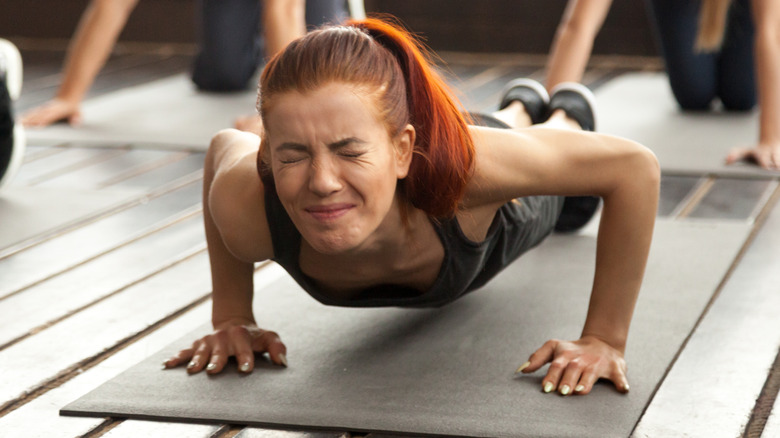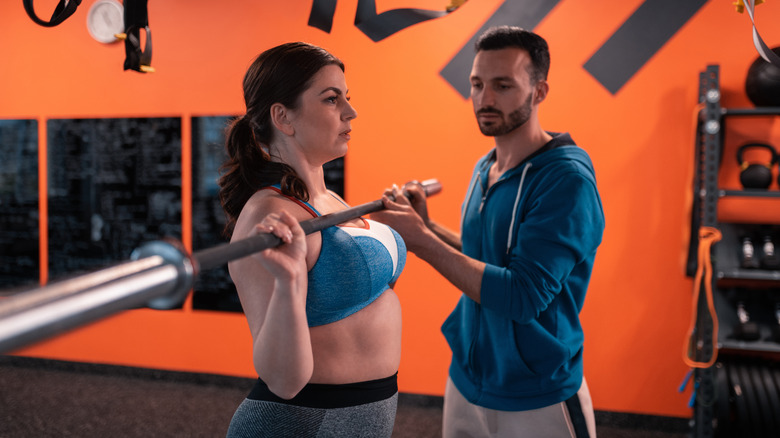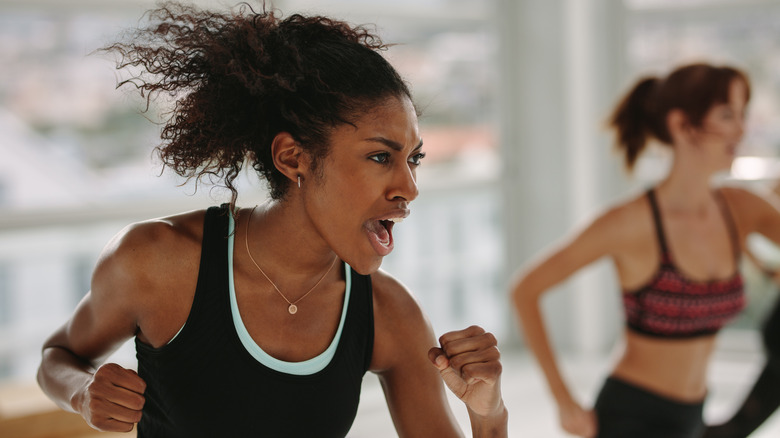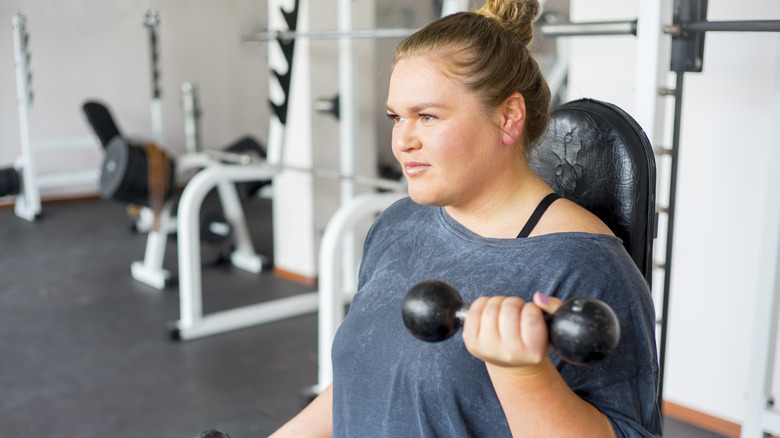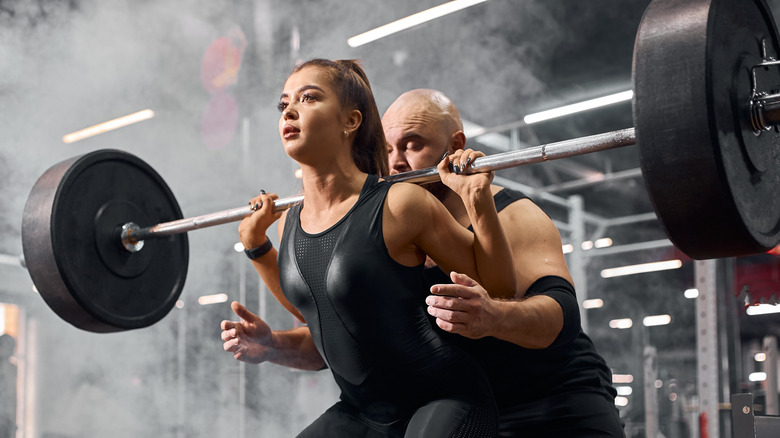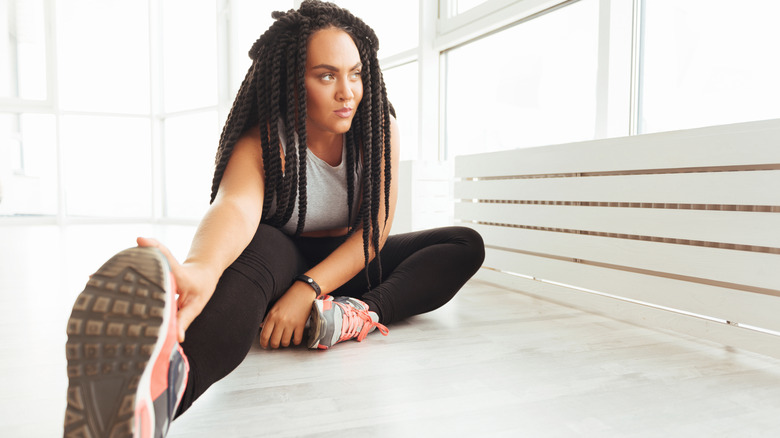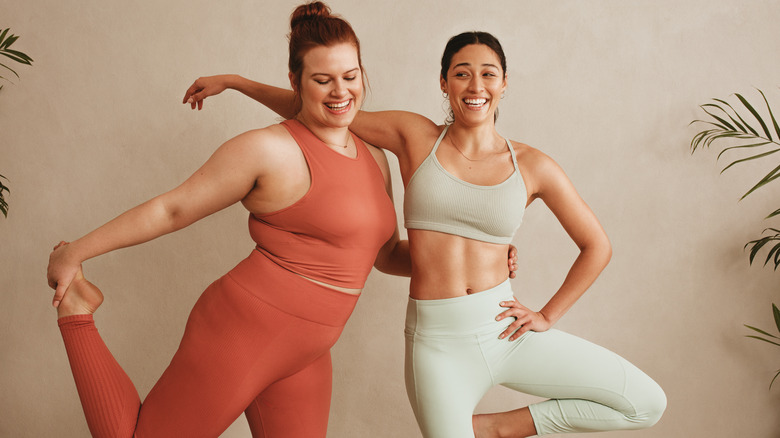9 Things You Don't Want To Hear From Your Trainer While Working Out
It makes a lot of sense, especially for people with busy lifestyles, to invest in a personal trainer. When you have a trainer, you cut out a lot of time spent thinking about what workout to do or how to operate exercise equipment. It helps to delegate that work to someone who knows exactly what they're doing. Having a trainer is especially helpful for people who are just starting out or people who need an extra push to show up at the gym. No need to think — just do!
With a good trainer, the right prompts at the right time can make or break your workout. Having a pro there to give you an extra push may take you further than you'd get on your own. And in most cases, a personal trainer will help you meet your fitness goals.
When choosing a trainer, though, you'll need to watch out for red flags, which can often come out in what they say.
Burn off that food you ate!
This is probably something you've heard a friend or two say before a workout. "I'll push myself harder so I can earn my meal later" or "I workout so I can eat more." Though seemingly innocent, this type of mindset could lead to a complicated relationship with food later on. And though you can't necessarily police your friends for their comments, this type of language is something you should definitely take note of if it comes from your trainer.
Burning off a meal isn't a good motivation for a workout, and it can put a lot of pressure on people who may already have a difficult relationship with food. Food should not be "earned" or serve as a reward for getting a workout in.
Certified strength and conditioning specialist Sohee Carpenter highlighted the harmful effects of this mindset on Instagram, writing, "Encouraging exercise to compensate for eating candy or eating anything you deem 'bad'? Big. Red. Flag." Carpenter went on to explain that viewing exercise this can lead to decreased enjoyment of exercise and increased anxiety toward food. This mindset has also been linked to eating disorders.
If you need help with an eating disorder, or know someone who is, help is available. Visit the National Eating Disorders Association website or contact NEDA's Live Helpline at 1-800-931-2237. You can also receive 24/7 Crisis Support via text (send NEDA to 741-741).
Body-shaming comments
Body shaming is a big no-no, including at the gym. It's hard enough for some people to get motivated to work out — the last thing they need is judgment to discourage them. Athlete, writer, and activist Ragen Chastain told The Washington Post about her experience as a plus-sized person in the fitness space, saying, "Fat people have to endure unwelcomed comments, judgments, and exclusions that can discourage our participation in fitness."
Instead of being a means of motivation, fat shaming is often counterintuitive. Our culture has internalized a stigma toward bigger bodies. Rebecca Scritchfield, a dietitian, physiologist, and author, explained the need for diversity in the fitness industry, especially when it comes to trainers (via The Washington Post).
Kjerstin Gruys, sociologist and body image activist, explained in an article for National Eating Disorders Association that many trainers have the impression that people are only at the gym to lose weight or alter their physical appearance. While weight loss may be a goal for some, it is not everyone's goal. Some are focused on strength and overall health. This is something all trainers should be mindful of as they build programs for their clients and in their interactions with others at the gym. As Gruys wrote, "If a trainer takes part in body-shaming, they are not only being rude, but are also harming the long-term health of their clients."
No pain, no gain
You've probably heard the phrase "no pain, no gain" a couple of times throughout your fitness journey. It's a go-to saying in the fitness space. When taken literally, though, it can be harmful. We're not saying that working out should feel like a spa visit. You should still feel some mild discomfort during exercise, especially if you're doing a challenging workout.
Carly Ryan, an exercise physiologist, spoke with ABC News about the distinction between discomfort and pain. "A little bit of a burn that goes away when your muscles stop working is often just a result of the exercise, so it's OK to continue. But if it continues and you're getting, say, a sharp pain in your knees or you feel a painful twinge in your hamstrings that affects your ability to keep moving, then it's most likely pain because you've overdone it, so you need to stop."
If you voice major discomfort and your personal trainer doesn't make adjustments to your workout, it's time to find a new one. "Understanding the difference between pain and soreness is something your trainer has to be able to listen to you about," Vince Sant, fitness trainer and founder of V shred, told NBC News. "Making you push through pain could be seriously threatening to your body."
Don't stop when it hurts; stop when you're done
Working out is no walk in the park, but it shouldn't be the most grueling part of your day either. "There may be a burn or you'll feel the fatigue, but there are very few times to push through actual pain in the gym," Josh Wolfe, fitness trainer and founder of WolfePack Fitness, told Livestrong.
Fitness trainer Ben Carpenter took to Instagram to explain that the relationship between a client and a trainer is a two-way street. Like any good relationship, the needs of the client need to be communicated with their trainer. "If you're a pro athlete training for the Olympics, chances are your strength coach is going to run a pretty militant regime, but if you are a client in a commercial gym setting, it's totally different," Carpenter explained. "You are paying for a luxury service, and if your trainer's gym programs are about as enjoyable as having your teeth pulled out, you can tell them to f*** off if you want."
The moral of the story is that you need to listen to your body, and so does your trainer. The phrase "don't stop when it hurts; stop when you're done" is counterintuitive to a safe and healthy fitness journey. Fitness isn't about going hard on your body and injuring it in the process. If anything, your fitness journey should be focused on preventing further injuries by building up strength and endurance so you can do everyday tasks better (via Livestrong).
Get bikini ready
The verdict is in: Every body is a bikini body. Full stop. However, when people in the fitness space bring up getting "bikini ready," we all know what they're referring to — the unattainable societal standard projected onto women's bodies. "If you are healthy and you move around and you eat well and exercise, it doesn't matter what your body structure is," Eric Martinez, an exercise physiologist, told Good Housekeeping. Looks are not a reliable indicator of one's health or strength, so it's best not to fixate on them too much.
At the end of the day, language matters. In 2021, fitness trainer and influencer Kayla Itsines recognized this need for change. She decided to rename her popular workout program called the "Bikini Body Guide" (popularly known as BBG) to "High Intensity with Kayla." BBG was launched back in 2014 and has gained a massive following since. While the program itself remains unchanged, Itsines asserts that the rebrand was necessary.
"I feel the name now represents an outdated view of health and fitness so as co-founder of Sweat, I feel it is the right time to change our approach with BBG and to evolve and use language that feels more positive for women today," Itsines explained in an Instagram post.
Unless you puke, faint, or die – keep going!
There's nothing to glorify in overexertion. Any trainer who tells you "Unless you puke, faint, or die – keep going!" (or anything similar) in the middle of a really difficult workout is wholly mistaken.
Fainting and dying are obviously not the outcomes anyone would want as a result of a workout. And although puking is sometimes a normal occurrence brought about by the temperature, your diet, or a new regimen, it's not something to be proud of — nor is it a signal to keep going (via Men's Health). Instead of pushing yourself past the nausea, sports medicine physician Dr. Justin Mullner recommends pacing yourself until you feel better or sitting out the workout and slowly drinking fluids.
If you routinely experience nausea after or during your workout and you're unable to pinpoint the root cause, Dr. Mullner advises scheduling a visit with your doctor.
Heavy lifting will make you bulk up
Lifting a heavy weight once will not suddenly make your body morph into that of a bodybuilder's. In fact, it takes a lot to reach that point, including years of training and adjustments to your diet. However, this outdated belief frequently discourages women from lifting weights because they are afraid of appearing bulkier or overly muscular.
Jacqueline Crockford, certified strength and conditioning specialist and spokesperson for the American Council on Exercise, told Shape, "If you perform resistance training one to three days per week and you're not eating more calories than you expend in a day, you probably won't see a ton of muscle growth." To build muscle, you must increase the calories you consume and accompany that with heavy weight lifting.
If weight loss is a priority in your fitness journey, weight training actually helps your body burn more, thereby aiding in fat loss and muscle toning (via CNET). But more importantly, it also aids in both physical and mental health.
The best time to work out is...
It doesn't make much sense for a trainer to tell you the optimum time to work out — unless they're giving you inside intel as to when the gym is the least crowded. Your trainer shouldn't force you to strictly adhere to a specific time of day to work out, especially if they cite "effectiveness" as their reasoning. The best time to work out is the time that fits your schedule.
A case can be made for exercising at any time of day. Morning workouts have been proven to encourage more movement outside of exercise than on a completely sedentary day. Other pluses include improved metabolism and better quality sleep, according to Healthline. Nevertheless, afternoon and evening workouts have your body performing at its best and are less likely to leave you injured (via Healthline).
Since we're all built differently and we work around different schedules and lifestyles, the most suitable time to work out is the time you can commit to. It's subjective, and all that really matters is that you show up.
Strong is the new skinny
In recent years, society has embraced a more body-positive mindset, which probably led to a shift in language. Instead of aiming to get skinny, many are aiming to get strong. Fitness trainer Karina Inkster wrote about the popular phrase "strong is the new skinny" in an article for Alive, writing, "[It] is certainly moving in the right direction, and in theory, the concept is great. In practice, however, it's used in ways that are not always conducive to creating a healthy body image." Not to mention, the idea of "strong" often connotes a very specific body type (via Psychology Today).
It is difficult, especially for women, to have society continually dictate what our bodies should look like. Claiming that being strong has replaced being skinny is another universally unattainable standard since everyone's bodies are different.
At the end of the day, the focus should not be on the way we look but on overall health. Inkster recommends focusing on performance — like being able to lift heavier weights or execute certain workouts with ease — rather than weight loss. If your personal trainer is more concerned with how you look, it's about time to look for a new trainer.


